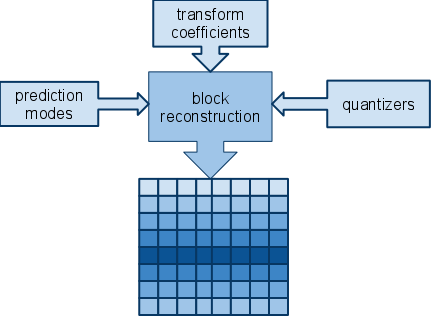Regarding my toy VP8 encoder, Pengvado mentioned in the comments of my last post, “x264 looks perfect using only i16x16 DC mode. You must be doing something wrong in computing residual or fdct or quantization.” This makes a lot of sense. The encoder generates a series of elements which describe how to reconstruct the original image. Intra block reconstruction takes into consideration the following elements:

I have already verified that both my encoder and FFmpeg’s VP8 decoder agree precisely on how to reconstruct blocks based on the predictors, coefficients, and quantizers. Thus, if the decoded image still looks crazy, the elements the encoder is generating to describe the image must be wrong.
So I started studying the forward DCT, which I had cribbed wholesale from the original libvpx 0.9.0 source code. It should be noted that the formal VP8 spec only defines the inverse transform process, not the forward process. I was using a version designated as the “short” version, vs. the “fast” version. Then I looked at the 0.9.5 FDCT. Then I got the idea of comparing the results of each.
input: 92 91 89 86 91 90 88 86 89 89 89 88 89 87 88 93
- libvpx 0.9.0 “short”:
forward: -314 5 1 5 4 5 -2 0 0 1 -1 -1 1 11 -3 -4
inverse: 92 91 89 86 89 86 91 90 91 90 88 86 88 86 89 89
- libvpx 0.9.0 “fast”:
forward: -314 4 0 5 4 4 -2 0 0 1 0 -1 1 11 -2 -5
inverse: 91 91 89 86 88 86 91 90 91 90 88 86 88 86 89 89
- libvpx 0.9.5 “short”:
forward: -312 7 1 0 1 12 -5 2 2 -3 3 -1 1 0 -2 1
inverse: 92 91 89 86 91 90 88 86 89 89 89 88 89 87 88 93
I was surprised when I noticed that input[] != idct(fdct(input[])) in some of the above cases. Then I remembered that the aforementioned property isn’t what is meant by a “bit-exact” transform– only that all implementations of the inverse transform are supposed to produce bit-exact output for a given vector of input coefficients.
Anyway, I tried applying each of these forward transforms. I got slightly differing results, with the latest one I tried (the fdct from libvpx 0.9.5) producing the best results (to my eye). At least the trees look better in the Big Buck Bunny logo image:

The dense trees of the Big Buck Bunny logo using one of the libvpx 0.9.0 forward transforms

The same segment of the image using the libvpx 0.9.5 forward transform
Then again, it could be that the different numbers generated by the newer forward transform triggered different prediction modes to be chosen. Overall, adapting the newer FDCT did not dramatically improve the encoding quality.
Working on the intra 4×4 mode encoding is generating some rather more accurate blocks than my intra 16×16 encoder. Pengvado indicated that x264 generates perfectly legible results when forcing the encoder to only use intra 16×16 mode. To be honest, I’m having trouble understanding how that can possibly occur thanks to the Walsh-Hadamard transform (WHT). I think that’s where a lot of the error is creeping in with my intra 16×16 encoder. Then again, FFmpeg implements an inverse WHT function that bears ‘vp8’ in its name. This implies that it’s custom to the algorithm and not exactly shared with H.264.


